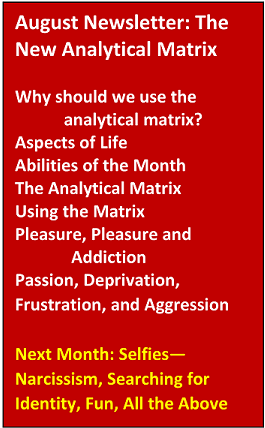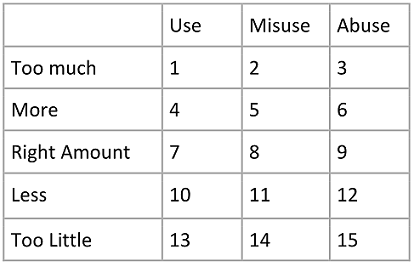THE NEW ANALYTICAL MATRIX Pdf
 In this newsletter, we introduce a new analytical matrix to be used as a tool for analysis, generating new understanding, and suggesting plans of action to create something new in your life. During your initial exploration of the matrix it may seem too abstract, which can be challenging and discouraging. However, putting the matrix into practice shows its usefulness and value. Suggestion: if you decide not to go into the details of the matrix, try to get a basic understanding of it.
In this newsletter, we introduce a new analytical matrix to be used as a tool for analysis, generating new understanding, and suggesting plans of action to create something new in your life. During your initial exploration of the matrix it may seem too abstract, which can be challenging and discouraging. However, putting the matrix into practice shows its usefulness and value. Suggestion: if you decide not to go into the details of the matrix, try to get a basic understanding of it.
WHY SHOULD WE USE THE ANALYTICAL MATRIX? ASPECTS OF LIFE
The analytical matrix is about the art and science of living. It is about creating balance and harmony in your life and in your relationships.
- Balance: the correct proportion of opposites (yin/yang), that is appropriate to a situation
- Harmony: being without conflict, external (with others) or internal (within yourself)
Appropriate helps create balance which helps create harmony. Appropriateness, balance, and harmony create effective action, i.e. action that gets us what we want in life.
We hope to demonstrate the usefulness of the matrix as an analytical tool by using it to explore some “aspects of life”: pleasure, passion, deprivation, frustration, and aggression. Aspects of life are the “stuff of life,” what we automatically use and experience as we live life. Life contains an almost unlimited number of aspects for us to use. For example, aspects of life are: qualities that we incorporate into our personality (like courage or honesty), values that we hold (like family or health), or life themes that we explore (like loving, power, or authority). These aspects of life can be run through the analytical matrix to test for appropriateness, balance, and harmony. The matrix can also show us the role that the aspects play in our life.
Point of Empowerment: Appropriateness is when an aspect of life “fits/works well with”, a situation. We observe the results of our actions, then use our thinking, feeling, and intuition to determine appropriateness.
Practice: As you go about your day notice which aspect of life is “alive”, i.e. present and active in a moment. If the aspect does not serve you, does not enhance your life, run it through the matrix to see how you need to change it.
Point of Empowerment: Even if you don’t use the matrix on a regular basis, understanding the principles behind it can guide you in consciously creating the life you want.

Craft the life you want. Carve it out of the tree of life.
ABILITIES OF THE MONTH: To use the matrix—observe what exists; see what is missing; think and feel to figure out why; devise a plan of corrective plan of action; put that plan into practice; repeat the cycle, with determination, until you get what you want. (The underlined words are aspects of life.)
THE ANALYTICAL MATRIX
 The analytical matrix is a table with a horizontal and a vertical axis. The horizontal axis is Use, Misuse, and Abuse. The vertical axis, referring to quantities, is Too much, More, Right Amount, Less, and Too Little. More and Less are quantities relative to the Right Amount. More and Less also refer to the actions of adding more to get a larger amount, or subtracting to get a smaller amount. The Right Amount is a quantity of some aspect of life that is appropriate to a situation. The “right amount” is about appropriateness, balance and harmony.
The analytical matrix is a table with a horizontal and a vertical axis. The horizontal axis is Use, Misuse, and Abuse. The vertical axis, referring to quantities, is Too much, More, Right Amount, Less, and Too Little. More and Less are quantities relative to the Right Amount. More and Less also refer to the actions of adding more to get a larger amount, or subtracting to get a smaller amount. The Right Amount is a quantity of some aspect of life that is appropriate to a situation. The “right amount” is about appropriateness, balance and harmony.
In living, we are often considering opposites; presence and absence, work and play, or rest and activity, for example. One day may be filled with work/activity, while another day is filled with play/rest. Taken together, work and play can be used creatively to have a balanced and harmonious week.
Also:
- Each row, column, and box has its own characteristics.
- Use, Misuse, and Abuse are often determined by the frequency of something.
- Boxes 8, 9, 5, 6, 2, and 3 are the “danger zone” of inappropriate more and more, and destructive too much.
- Boxes 8, 9, 11, 12, 14, and 15 are the “danger zone” of inappropriate less and less, and destructive too little.
- Moving from one box to the next occurs over time. The movement can be in one direction or the other, adding more or subtracting to get less. We can of course decide to reverse directions if we are heading in a destructive direction, or if we decide that we need positive change in our life.
Point of Empowerment: The concept “appropriate” is complex and constitutes part of the “art and science of living”. Appropriate is discovered as you discover what works and does not work in your life, and in life itself.
USING THE MATRIX
Let’s explore the matrix by using it to give us new understandings about some aspects of life.
PLEASURE
In using the matrix to understand pleasure, we ask ourselves: “How would we use the matrix to create the right amount of pleasure in our life?” The answer depends on the set of circumstances we are experiencing. For example:
- We want the right amount of pleasure (box 7) in our daily life; maybe cooking and enjoying a meal, watching TV, talking to someone whose company we enjoy, or playing a game with our family.
- On vacation, we want to add pleasure, having a larger amount (box 4, more/use), so we make sure that we enjoy our vacation.
- On a day filled with unpleasant chores, we reduce our expectations for pleasure, and use our self-discipline to accomplish what we need to do. If we have a work deadline we may “bite the bullet”, knowing that the pleasure comes from our accomplishment when we are done. (box 10, less/use)
The Misuse and Abuse of Pleasure—Boxes 8, 9, 5, 6, 2, 3. The Danger Zone
At times, we do certain things that use pleasure inappropriately, in ways that misuse pleasure (box 8). For example:
- If we want to procrastinate (avoid doing unpleasant tasks), we might have a bowl of ice cream, watch TV, or spend too much time at the gym.
- We demand frequent sex with our partner, which covers up problems in our relationship.
- We get high (pleasure) with the purpose of avoiding the painful feelings we have.
If our inappropriate use of certain activities becomes more frequent, our use of pleasure becomes abusive (box 9). This can take us into box 5 (more/misuse) and then into box 6 (more/abuse), if we are not careful. If we continue adding more and more, we are at serious risk of becoming addicted (box 2, too much/misuse). Continuing this pattern of behavior brings us into box 3 (too much/abuse). This is the very dangerous place of addiction, where we are behaving in compulsive ways that are out of our control. We are trapped.
Point of Empowerment: Boxes 5, 6, and 2 are the road to addiction. To prevent addiction, we need to use pleasure wisely.
Practice: Notice if you, or someone you care about, are moving through the matrix toward box 3. You (or someone you know) are indulging in dangerous amounts of pleasure, running the risk of becoming addicted.
Point of Empowerment: Addictions can begin with appropriate use of pleasure. But, as we misuse and abuse pleasure, we can become addicted. Preventing addiction involves having the right amount of pleasure in our lives: having and enjoying pleasure daily in a way that sustains, nourishes and enriches us. Also, recovery from addiction must include experiencing pleasure.
Necessary Pleasure. Too Little Pleasure
Pleasure nurtures us, gives us an experience of the good in life, and leads us into happiness, joy, bliss and ecstasy. It is necessary to have pleasure in our life and we therefore suffer if we have too little (boxes 14 and 15). We run the risk of “shutting down” to pleasure and becoming depressed.
PASSION
Let’s consider a kind of pleasure called passion. Passion is the intense experience of focused attention, with enthusiasm and joy. In box 7 (right amount/use), we can be passionate about:
- Loving our family
- Our work
- Our creative activities: painting, cooking, writing, creating our crafts, or gardening
- Our sporting activities: golf, exercising, or rooting for our favorite teams
- Our recreational activities: going to the movies, hanging out with and talking to friends, or reading
Our passions enrich our life. However, if we spend excessive amounts of time in the activities of our passion, even though we enjoy them, we begin to misuse passion (box 8). Continuing this pattern of adding more and more time sends us into the “danger zone,” (boxes 9, 5, 6, 2, and 3). If we find ourselves in box 3 we are again in the place of obsession, addiction, and possibly the manic state of Bipolar Disorder. But, box 4 (too much/use) is “being passionate about being passionate,” a wonderful place to be in!
While less passion does not generally cause us suffering, too little/abuse (box 15)—no passion ever—is a state of deprivation that causes us great suffering.
DEPRIVATION
Is there a right amount of deprivation? In the matrix, less balances out more. In life, deprivation balances the excess of self-indulgence. If we are indulging in distorted/self destructive aspects of life, we can seek balance by subtracting, having less, and heading toward the “right amount of deprivation.” Excessive anger, greed, and obsession with power are just a few self-indulgences that we could have less of. As we correct these excesses we may feel temporarily deprived, but ultimately, we reach a state of balance that brings us harmony.
However, less and less and less of things that we need or want brings us into too little/misuse, box 14. Chronic “too little/misuse” brings us into serious states of deprivation (box 15, too little/abuse), which puts our health and well-being in jeopardy. In deprivation, we miss out on pleasure, happiness, joy, fun, love, excitement, challenge, interest, curiosity, fascination, mystery, and beauty—the wonderful aspects of life.
FRUSTRATION
- The right amount of frustration is a motivator, propelling us toward getting what we need, want and desire.
- Too much frustration is a state of deprivation; not getting enough of what we need, want and desire.
- Too little frustration, living in the state of constantly getting what we want, creates narcissistic entitlement. This person believes that he deserves to have whatever he wants. She is filled with rage and throws temper tantrums (which can be violent), if she experiences frustration. He or she alienates everyone around them and lives a loveless life.
AGGRESSION
- The right amount of aggression is called assertiveness—a person uses her will, with an appropriate amount of power, to satisfy her needs, wants, and desires.
- Too much aggression is the overuse of power, force, and violence.
- Too little/misuse or abuse is extreme passivity. This degree of passivity makes a person a “victim” in life. They are often on the receiving end of many kinds of painful aggression perpetrated by other people.

All the abilities you need to use the
Analytical Matrix are described in
The Operating Manual for the Self.
WHAT IS LIVING?
Point of Empowerment: A final thought—living involves taking a human need, selecting an aspect of life, putting it through the matrix, and behaving in a way that fulfills that need.
IN CONCLUSION
A matrix is a structure and an analytical tool. The new analytical matrix has shown us some of the underlying structure of the life that we live. As a tool, it can bring us empowering new ways to transform ourselves and our life. We have only begun to scratch the surface of the matrix, and hopefully the future will bring us new opportunities for further exploration.
Let’s unite in developing our human potential. Share this newsletter with others. Please visit our website, IIFSD.org. We invite you to participate, (as suggested in the Participation Menu selection). When you buy The Operating Manual for the Self (manualfortheself.com), you support our vision and mission. When you read The Operating Manual for the Self, you leap forward in your personal self-development and evolution.
Copywrite IIFSD.org, 2017. All rights reserved.
